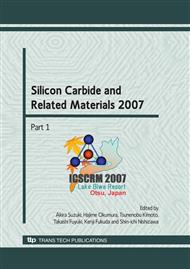p.855
p.859
p.863
p.867
p.871
p.875
p.879
p.883
p.889
Novel Use of Columnar Porous Silicon Carbide Structures as Nanoimprint Lithography Stamps
Abstract:
Columnar porous Si-face 6H-SiC substrates were prepared by a photo-electrochemical etching method and applied as nanoimprint lithography (NIL) stamps. The diameter of the pores in the porous region was about 20 nm and the center-to-center separation between pores was about 60 nm. The columnar porous SiC substrates were subjected to a vapor phase silanization treatment whereby a monolayer of perfluorooctyltrichlorosilane (FOTS) was deposited in order to keep the stamps from sticking to the substrates during the imprint step. Subsequently, the porous SiC stamps were used to imprint polymethylmethacrylate (PMMA) at elevated temperatures and pressures. The imprinted PMMA could then be used to transfer the nanopattern on the columnar porous SiC to other substrates for various purposes; e.g. templates for GaN regrowth, catalysts for nanowire growth by vapor-liquid-solid type methods (VLS), etc. SiC is not typically used for NIL stamps since etch processing of SiC is less mature than that of Si. However, as demonstrated here, there is no reason why SiC cannot be used as a material for NIL stamps. The superior mechanical properties to Si make the use of SiC alluring as a master template for NIL processing.
Info:
Periodical:
Pages:
871-874
Citation:
Online since:
September 2008
Authors:
Price:
Сopyright:
© 2009 Trans Tech Publications Ltd. All Rights Reserved
Share:
Citation:


